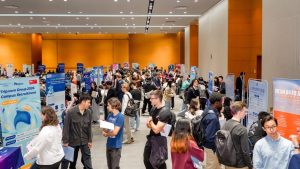31 Oct 2024
For the more than one billion people suffering from migraines each year across the world and despite existing therapeutic options, many still endure persistent photophobia, a symptom that affects nearly 90% of those with migraines.
A study led by Professor Minyan Wang, Department of Biological Sciences, School of Science at Xi’an Jiaotong-Liverpool University (XJTLU), in collaboration with the University of Liverpool and Murdoch University in Australia, has made significant advances in understanding the molecular basis of photophobia. The research highlights the role of Src family kinases (SFKs) in migraine pathophysiology, revealing gender-specific effects and suggesting new precision medicine approaches for treatment.

One of the 1st author, PhD student Zhuoan Huang (Back left 2), Professor Wang’s research team
Tackling Unmet Needs in Migraine Research
Migraine is a recurrent unilateral headache that impacts 15% of the global population and is three times more common in women than men, making it the second leading cause of disability worldwide. Up to 90% of migraine sufferers experience photophobia during attacks, with 75% continuing to experience light sensitivity between episodes.
“Despite existing treatments, the underlying molecular mechanisms remain poorly understood. We aimed to explore the molecular basis of photophobia and identify potential therapeutic strategies,” explains Professor Wang. The team’s investigation into Src family kinases (SFKs) antagonism on light aversion behavior marks a critical step in understanding how these enzymes contribute to migraines.
Findings in Precision Medicine
The study introduced a rapid-onset, injury-free model of photophobia in mice, offering a new research tool that minimizes stress-induced variability. This model enabled researchers to observe that SFK antagonism reduced light aversion in male mice, but not in females. This discovery, linked to gender-specific differences in gene expression involving ion channels and kinase receptors in the trigeminal ganglion, could inform future targeted treatments.
“Our findings provide new insights into migraine’s molecular mechanisms and demonstrate the potential of SFK antagonism as a therapy for photophobia-related conditions,” says Professor Wang. “This underscores the importance of precision medicine in addressing the unique biological pathways in migraines, particularly in gender-specific contexts.”

Devices for monitoring mice photophobia behaviour
Furthermore, SFK-targeted therapies could potentially be repurposed, providing cost-effective treatment options since their safety has already been established in clinical trials.
This research also involved School of Science, XJTLU PhD student Zhuoan Huang and Master’s student Junyu Yao, along with contributions from undergraduate students in Professor Wang’s lab. It highlights the collaborative and innovative environment in the School of Science and XJTLU, serving as an inspiration for future scientists.
The study“Gender-different effect of Src family kinases antagonism on photophobia and trigeminal ganglion activity” published in The Journal of Headache and Pain(Spring Nature Journal, 5-year impact factor = 7.7). Click here to read this paper.
About the researcher:
Minyan Wang joined at XJTLU in the Department of Biological Sciences, School of Science in 2011. She is currently Professor, Director of Centre for Neuroscience jointly founded by Wangwenli Charitable Foundation and XJTLU. She holds an honorary staff position at the University of Liverpool and is PhD supervisor at the Institute of Systems, Molecular and Integrative Biology, University of Liverpool, UK. Prior to her position at XJTLU, she held a lecturer position at the School of Pharmacy and Biomedical Sciences, University of Central Lancashire, UK from 2008-2011. Additionally, she completed two postdoctoral trainings at the University of Newcastle and University of Bradford, UK from 2004-2008. She was awarded of PhD in Neuropharmacology in 2004 at the University of Bradford, UK, and obtained 1st degree in Pharmacy in 1988 and MSc in Pharmacology in 1997 at Hebei Medical University. She has rich experience in curriculum design and development in Higher Education and holds an MA degree in teaching and learning in Higher Education, UK. Her research projects focus on molecular mechanisms of migraine pain and drug target identification.
Much of Professor Wang’s work has been in migraine research, but also conducted evaluation of pharmaceutical drugs for treating epilepsy, ischemia, and diabetes. Over the past 2 decades, she has dedicated her career to pioneering research in migraine pathogenesis.
More details about her publications can be also found via the URL (https://www.researchgate.net/profile/Minyan_Wang).
By Luyao Wang
Translation: Luyao Wang
Review and photos: Professor Minyan Wang
31 Oct 2024







